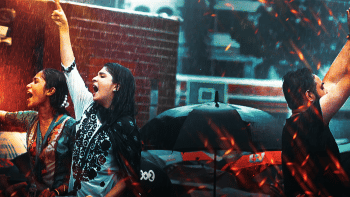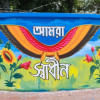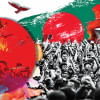If we flip the pages of history, we will find that rap and hip-hop music has been a powerful medium for expressing discontent, rallying causes, and standing up to authority. Although other forms of music also contributed in their own way, there is something about hip-hop music when it comes to challenging established power structures that sets it apart from the others.
You can argue that it's the beat that mostly gets us pumped up or the anger in the voice of the artist that perfectly encapsulates our frustration and desperation or the underlying raw messages of the lyrics. Either way, its ability to articulate the frustrations of the oppressed and grieved is second to none, and it can perfectly utilise the power of rhythm and rhetoric to inspire unity and collective action.
It's precisely these characteristics that made hip-hop a pivotal part of the Quota Reform Movement that took place throughout the past month. The various songs that were made during this time gave the protesters hope, it fuelled their rage and gave them the courage to confront the system of power and eventually topple it. The songs and the artists behind the music essentially became the frontline of the resistance.
The significance of rap in global movements
The role of rap and hip-hop in the quota reform movement underlines its longstanding history of representing and championing underserved communities as an activist voice and movement builder. For decades, artists have been using it as a powerful medium for expressing dissent, reflecting on social injustices, and highlighting various causes and struggles that plague society.
In the United States, rap music has long been intertwined with social and political activism. During the late 1980s and early 1990s, groups like N.W.A and Public Enemy, and artists such as Tupac Shakur used their music to address issues of police brutality, systemic racism, and economic disenfranchisement. Their raw, unapologetic lyrics resonated with a generation grappling with these issues, turning their music into anthems of resistance and agents of change.
A more recent and relatable example for us would be American rapper Macklemore's single, titled Hind's Hall, which sheds light on the oppression and war crimes being committed on Palestine. It became a beacon of hope for Palestine and its people, who received little to no coverage from international media or international artists.
How injustice during the Quota Reform movement inspired a wave of artists
Most of us are pretty well aware of what went down during the Quota Reform movement at this point, so we won't go into much details. However, it is very important to understand certain nuances of the events which inspired the rappers to turn to their medium to vent out their frustration. What started out as a bid to restore balance to a system that is meant to promote inclusivity but lost its way, led to the streets being painted with the blood of the protestors.
The response from the authorities widened the disparity and narrowed the platform for protesters to speak up. Their bid to stop oppression only saw them get oppressed even further. The countless tales of injustices only built up more rage within the masses. The time to speak up was now, and this is when the rappers stepped up with their music.
The likes of Shezan, Hannan, Lunatix Veer, Gold Cube released tracks which are now synonymous with the movement and became the anthem of the oppressed and the voiceless. They became a medium to aid the protestors to voice their frustrations, gather their thoughts and move forward with courage. What started out as a reform movement transformed into a struggle for liberation.
Shezan: one of the standout rappers of the movement
Among all the songs that were released, "Kotha Ko" by Muhammad Shezan, also known as Shezanbeats, really stood out. The combination of the hard hitting beat and gritty lyrics, coupled with the fire within Shezan's voice turned "Kotha Ko" into one of the anthems of the movements. At the time of writing this, it has over 3 million views on YouTube.
"I never thought that things would go so out of hand. To the point where students were getting beaten up mercilessly. That too by people who are meant to protect us," Shezan recalls. "I was hurting. The posts and the live videos were getting to me, and I wanted to do something about it. I just had to. And I know that I wasn't the only one feeling this way. Everyone was pretty much going through the same thing and I wanted to convey our collective hurt and frustration through my art. So, I just started recording. No plans, no thoughts just pure emotions," he explains.
"Kotha Ko" went viral immediately upon being released, but Shezan didn't stop there. He actively joined the protests being held in his area of Narayanganj. "The day after I released the song, my friends and I led juniors and students from my community into the protests being held in my area. It was surreal," he describes.
How Shezan and others impacted the movement
"Kotha Ko" was not just a song, but a call to action solidified by Shezan's active involvement in the protests. The song contributed to shaping the movement's identity, direction, and narrative. The energetic beats and the powerful words not only gave protesters reassurance, but also gave them the courage they needed to go on and see things through.
"A lot of the lines from the song were inspired by things that were actually being felt by the protesters. I just wanted to amplify their voices that was constantly being put down by authorities," states Shezan.
"Kotha Ko" played a crucial role in galvanising the youth and gave them a platform to let all of their emotions out. For many protesters, the music provided a form of emotional and psychological support, helping them to stay motivated and focused amidst the adversity and atrocity they faced. The song became a source of inspiration and resilience and acted as the vehicle the students needed to bring about change.
"Hip-hop's raw and unfiltered nature allows us rappers to say things as they are, without having to sugar-coat it and this is exactly what the movement called for. People of all ages were being tortured, taken away. We didn't even know how many lives were lost. There was just so much distress, anger, and frustration. Hip-hop was the perfect avenue to let it out," he adds.
According to Shezan, almost the entire hip-hop community contributed to the movement in one way or the other and the listeners helped to spread our word even further. Moreover, the anthems created by Shezan and other rappers helped to bridge gaps between different groups. Regardless of whether or not you were a student, these songs helped foster a sense of solidarity and shared purpose within whoever listened to them.
The songs spoke to and inspired people of all ages and from all walks of life. They encouraged them to come together and fight for what's right. The songs' messages resonated with the masses and helped to broaden the movement's reach. Not even a literal blackout was able to put out the fire started by the hip-hop artists.









Comments